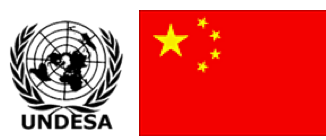The UN Department of Economic and Social Affairs (DESA) announced a study of how China's ‘Silk Road' regional cooperation initiatives are contributing to the 2030 Agenda for Sustainable Development, the Sustainable Development Goals (SDGs) and the seven action areas of the Addis Ababa Action Agenda on financing for development (AAAA).
DESA will conduct the study through a capacity development project in cooperation with China.
 16 August 2016: The UN Department of Economic and Social Affairs (DESA) announced a study of how China’s ‘Silk Road’ regional cooperation initiatives are contributing to the 2030 Agenda for Sustainable Development, the Sustainable Development Goals (SDGs) and the seven action areas of the Addis Ababa Action Agenda on financing for development (AAAA). DESA will conduct the study through a capacity development project in cooperation with China.
16 August 2016: The UN Department of Economic and Social Affairs (DESA) announced a study of how China’s ‘Silk Road’ regional cooperation initiatives are contributing to the 2030 Agenda for Sustainable Development, the Sustainable Development Goals (SDGs) and the seven action areas of the Addis Ababa Action Agenda on financing for development (AAAA). DESA will conduct the study through a capacity development project in cooperation with China.
China launched the ‘Silk Road Economic Belt’ and ’21st Century Maritime Silk Road’ initiatives in 2013 to promote policy coordination, connectivity, trade, financial integration and social and cultural ties, potentially linking 65 countries in Asia, Europe and Africa. The plans also include the development of green and low-carbon infrastructure.
Pingfan Hong, DESA, said that, while the “Belt and Road” initiatives are different in nature from the 2030 Agenda, they share some basic principles, including the promotion of peace and cooperation, openness, inclusiveness and mutual trust.
DESA notes that the countries included in the Silk Road cooperation initiatives account for about 60% of the world’s population, 30% of global GDP, 40% of world trade, and more than 50% of the world’s poor. [DESA Press Release] [Development Policy and Analysis Division Website] [Preliminary Study by Pingfan Hong]